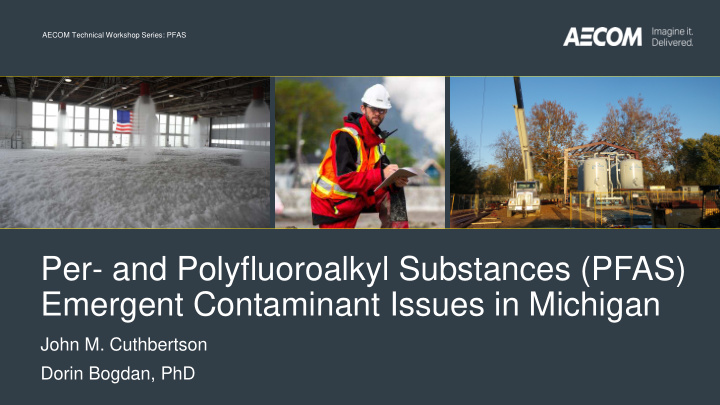



AECOM Technical Workshop Series: PFAS Per- and Polyfluoroalkyl Substances (PFAS) Emergent Contaminant Issues in Michigan John M. Cuthbertson Dorin Bogdan, PhD
What is an Emerging Contaminant? Chemicals and materials that have pathways to enter the environment and present real or potential unacceptable human health or environmental risks… and either Do not have peer-reviewed human health standards or Standards/regulations are evolving due to new science, detection capabilities or pathways AECOM Technical Workshop Series: PFAS 2
PFAS Development…. 1930’s 1930’s 1940’s 1940’s 1950’s 1950’s 1960’s 1960’s Teflon accidentally Aqueous Film Forming Teflon used in the Consumer and industrial discovered in 1938 Manhattan Project for Foam (AFFF) is products (Polymers) the development of the developed atomic bomb AECOM Technical Workshop Series: PFAS 3
… and Evolution 1970’s 19 70’s 2000’s 2000’s Current Use of PFAS Global distribution of certain Increased public scrutiny significantly expands PFAS in biota Changing regulatory climate in different industries Lawsuit settlements Voluntary phase out of products Development and use of new PFAS AECOM Technical Workshop Series: PFAS 4
Terminology Evolution: PFCs vs. PFAS PFC PFAS PFAS The terminology and classifications of these PFC compounds have evolved • Perfluorinated Compounds (PFCs) – Past • Per- and Polyfluoroalkyl Substances (PFAS) - Current Per fluorinated Poly fluorinated All carbon atoms fully fluorinated Some carbons are not fully fluorinated AECOM Technical Workshop Series: PFAS 5
Chemical Properties “Per” – All of the C-H groups are replaced by C-F Carbon-fluorine bonds – Very strong, inert – Resistant to thermal, chemical, and biological degradation – Surfactant, reduce surface tension – Hydrophobic and oleophobic (repel water and oil/fat/grease) Functional Group Hydrophilic Hydrophobic AECOM Technical Workshop Series: PFAS 6
PFAS Chemical Enhancement 1967 – USS Forrestal fire 1978 – DC-10 Crash (Protein Foam) (AFFF – PFAS Foam) AECOM Technical Workshop Series: PFAS 7
Industrial Use of PFAS Building and Chemicals and Apparel Aerospace Electronics Construction Pharmaceuticals Healthcare and Aqueous Film Energy Oil & Gas Semiconductors Hospitals Forming Foam AECOM Technical Workshop Series: PFAS 8
Increased Interest on PFAS PFAS in RED are those that have been restricted under national/regional/global regulatory or voluntarily frameworks, with or without specific exemptions. Wang et al., 2017 ES&T AECOM Technical Workshop Series: PFAS 9
Increased PFAS Applications Number of approved patents per month in the USA with “perfluoro” in the patent text AECOM Technical Workshop Series: PFAS 10
Exposure and Potential Health Effects Primary human exposure pathways Wide range of observed effects: Drinking Water Dietary ingestion • Endocrine/thyroid effects • Changes in cholesterol • Liver cell effects • Decreased body and organ weights • Tumors 11 AECOM Technical Workshop Series: PFAS
Statewide PFAS Investigations in Michigan 2010-2014 SW & Fish Sampling 2001 SW Sampling 2011 State of Knowledge AECOM Technical Workshop Series: PFAS 12
Potential PFAS Discharges in Michigan Surface Water Groundwater AECOM Technical Workshop Series: PFAS 13
Regulatory Climate • No regulatory or environmental concerns 1930’s - 2000 • Initial environmental concerns documented • US EPA Provisional Health Advisory (HA) 2001 - 2009 (PFOA = 400 ppt, PFOS = 200 ppt) • Individual states developing criteria • US EPA Lifetime HA (PFOA, PFOS, or PFOA + PFOS = 70 ppt) 2010 - 2017 AECOM Technical Workshop Series: PFAS 14
PFAS News in Michigan AECOM Technical Workshop Series: PFAS 15
Regulatory Direction • PFAS manufacturers Initial • Department of Defense (AFFF) Current • Other AFFF users? • Landfills, WWTPs? Next? • End user manufacturers? 16 AECOM Technical Workshop Series: PFAS
Proposed Michigan Part 201 Criteria Residential Non-Residential Groundwater-Surface Drinking Water Drinking Water Water Interface PFOA 70 89 70 280 12,000 PFOS 70 80 70 660 12 Un Units : ts : Wate ter = = ng/L (ppt pt) AECOM Technical Workshop Series: PFAS 17
Dealing with Part Per Trillion Levels 1 ppt = 1 drop (0.05 mL) in 20 Olympic Swimming Pools Note: 1 Olympic Pool = 660,000 gallons 18 AECOM Technical Workshop Series: PFAS
Challenges Analytical Sampling – Methodology – Stringent SOPs – Detection limits – Cross contamination – Cost $ – Decon water – Turnaround times Investigation / Remediation – Potential sources – Widespread – Treatment options – Potential re-opener AECOM Technical Workshop Series: PFAS 19
Potential Re-Opener AECOM Technical Workshop Series: PFAS 20
Key Take Away Points Unlike contaminants we’re familiar with o Widespread / mobile o Potential health risks o Difficult to remediate Evolving Quickly o Regulations, policy, laboratory analysis, toxicity, fate & transport, treatment technologies are evolving quickly Other Considerations o Media / Residents / Public perception AECOM Technical Workshop Series: PFAS 21
Thank You! John M. Cuthbertson Dorin Bogdan, PhD Midwest PFAS Practice Lead PFAS Technical Practice Group Leader o Grand Rapids, MI o Grand Rapids, MI o (616) 516-5995 o (616) 481-4009 o dorin.bogdan@aecom.com o john.cuthbertson@aecom.com AECOM Technical Workshop Series: PFAS
Recommend
More recommend